Related Research Articles
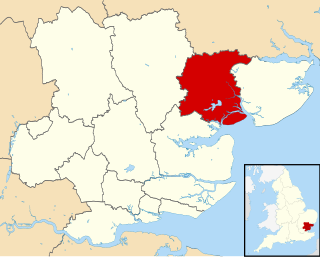
The Borough of Colchester is a local government district and borough in Essex, England, named after its main town, Colchester. The borough covers an area of 125 square miles (320 km2) and stretches from Dedham Vale on the Suffolk border in the north to Mersea Island on the Colne Estuary in the south.

Mersea Island is an island in Essex, England, in the Blackwater and Colne estuaries to the south-east of Colchester. Its name comes from the Old English word meresig, meaning "island of the pool" and thus is tautological. The island is split into two main areas, West Mersea and East Mersea, and connected to the mainland by the Strood, a causeway that can flood at high tide.
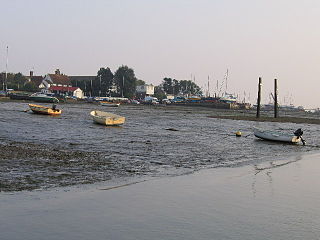
West Mersea is a town and electoral ward in Essex, England. It is the larger of two settlements on Mersea Island, south of Colchester.

West Mersea Yacht Club (WMYC) is a British yacht club that has its clubhouse in Coast Road, West Mersea, Mersea Island, Essex. It is on the estuary of the River Blackwater, approximately 12 km (7.5 mi) south of Colchester. The Blackwater estuary is a major sailing centre on the English east coast.
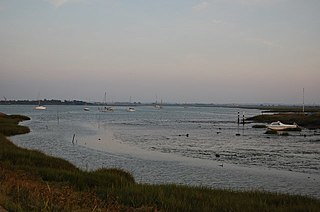
The Blackwater Estuary is the estuary of the River Blackwater between Maldon and West Mersea in Essex. It is a 5,538 hectare biological Site of Special Scientific Interest (SSSI). An area of 4,395 hectares is also designated a Ramsar Wetland of International Importance, and a Special Protection Area 1,099 hectares is a National Nature Reserve. Tollesbury Wick and part of Abbotts Hall Farm, both nature reserve managed by the Essex Wildlife Trust, are in the SSSI.
Colne Priory at Earls Colne, Essex was a Benedictine priory, initially a dependent cell of Abingdon Abbey, Berkshire. It was founded by Aubrey de Vere I and his wife Beatrice in or before 1111. Their eldest son Geoffrey had died at Abingdon about seven or eight years earlier and was buried there. On his deathbed, Geoffrey had bequeathed to Abingdon the church and lands at Kensington, Middlesex, and his parents and brothers had confirmed that grant, as had King Henry I.

Hatfield Broad Oak Priory, or Hatfield Regis Priory, is a former Benedictine priory in Hatfield Broad Oak, Essex, England. Founded by 1139, it was dissolved in 1536 as part of Henry VIII's dissolution of the monasteries.

Ray Island, also known as the Ray, is a 40.5 hectare nature reserve west of Mersea Island in Essex. It is owned by the National Trust, who bought it in 1970. It was leased by the National Trust to the Essex Wildlife Trust managed the site. Following the cessation of the lease associated with the associated with the island the National Trust has resumed responsibility for its management.

Thomas Lord Audley School is a mixed 11–16 secondary school with academy status for 800 pupils, to the south of Colchester, Essex. It serves a wide catchment area, taking students from the edge of Colchester, small villages and the community of Mersea Island. The school building is modern, with single, double and three-storey accommodation with hard play areas and a playing field. There are six science laboratories and six technology Suites. The PE facilities include a sports hall, fitness suite and gym. As of 2009, the school also has new drama and music facilities and a new suite of modern language rooms.

Prittlewell Priory is a medieval priory in the Prittlewell area of Southend, Essex, England. It was founded in the 12th century, by monks from the Cluniac Priory of St Pancras in Lewes, East Sussex, and passed into private hands at the time of the Dissolution of the Monasteries under Henry VIII. The last private owner, the jeweller R. A. Jones, gave the priory and the grounds to the local council. The grounds now form a public park, Priory Park, and the Grade I listed building is open to the public as a museum. Priory Park is located adjacent to the priory. The remains of the priory are a scheduled monument.
Berden Priory was a priory in Essex, England. This site now has a Grade II* listed late 16th-century timber-framed house, the centre of Berden Priory Farm.
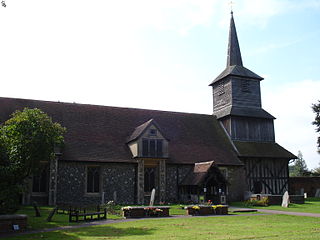
Blackmore Priory was a priory in Essex, England. It was established as an Augustinian Priory with a Prior and twelve Canons, who were not monks but ordained priests. They would be expected to work in the parish as well as lead a monastic life in the Priory.
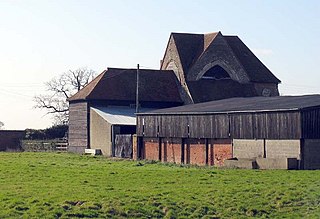
Latton Priory was a small priory in Essex, England. Its site is about 1 km south of the outskirts of the modern town of Harlow.

Little Dunmow Priory in Little Dunmow was an Augustinian priory in Essex, England. The priory was founded as a church by Juga de Baynard in 1104, dedicated to the Blessed Virgin Mary and consecrated by Maurice, bishop of London. Juga was the widow of Ralph Baynard, baron of Little Dunmow, sheriff of Essex and builder of Baynard's Castle in the City of London, since demolished. Her son Geoffrey was sheriff of Yorkshire who, in 1097, beat William II, Count of Eu in a trial by battle. After her death (c.1106), and following her wishes and the advice of Anselm, bishop of Canterbury, Geoffrey populated Juga’s church with Augustinian canons. In 1110, Lady Juga’s grandson, and Geoffrey’s son, William de Baynard, fell from grace and lost his lands. Henry I gave those lands to Robert Fitz Richard, but Henry and his wife Matilda of Scotland confirmed the canons’ possessions in Little Dunmow. Robert’s wife Maud, the step-daughter of Matilda’s brother David I, gave more lands to the canons, establishing the priory in perpetuity.
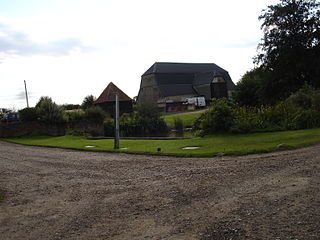
Panfield Priory was a priory of Augustinian Canons Regular sited in Panfield, Essex, England.
Takeley Priory, dedicated to Saint Valery, was a Benedictine monastery in Takeley, Essex, England, founded by William the Conqueror between 1066 and 1086, that is to say, after the Conquest and before Domesday Book. The priory, with substantial landholdings in Essex and Middlesex, was given to the Abbey of Saint-Valery in Normandy, as a thank-offering for their assistance in facilitating William's crossing of the Channel in 1066 to invade England.
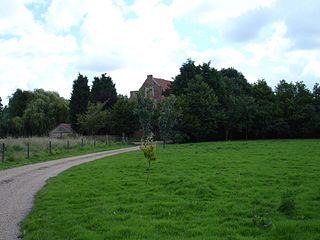
Tiptree Priory was a small Augustinian priory in Great Braxted, Essex, England and afterwards the name of the 16th century house built on the ruins.
Moatenden Priory was a priory located at Headcorn, about six miles south of Maidstone in Kent, England.
Mersea Fort, also known as Cudmore Grove Blockhouse, was an artillery fort established by Henry VIII on the East Mersea coast in 1543. It formed part of the King's Device programme to protect against invasion from France and the Holy Roman Empire, and defended the River Colne that led to the town of Colchester. It was triangular in shape, with earthwork walls and three bastions to hold artillery. It was demobilised in 1552, but was brought back into use several times over the next century and saw service during the Second English Civil War of 1648. The fort hosted an admiralty court to oversea the local oyster trade, until the dilapidation of the site forced the court to move to the Moot Hall in Colchester in the middle of the 18th century. A new gun battery was built at the fort during the Napoleonic Wars, but the fortification then fell into decline and was extensively damaged by the construction of a sea wall along the coast. The remains of the earthworks were excavated by archaeologists between 2002 and 2003.
References
Coordinates: 51°46′33″N0°54′49″E / 51.775700°N 0.913582°E